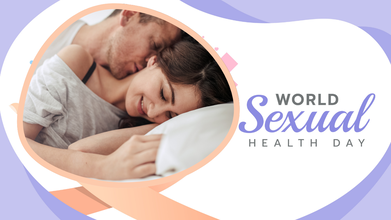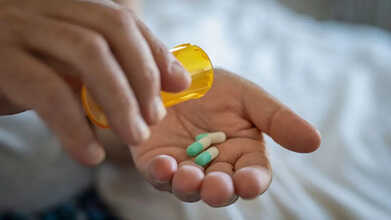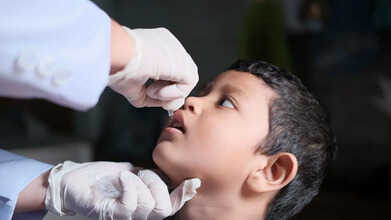- Health Conditions A-Z
- Health & Wellness
- Nutrition
- Fitness
- Health News
- Ayurveda
- Videos
- Medicine A-Z
- Parenting
- Web Stories
World Sexual Health Day 2025: Theme, Significance And What You Can Do To Make Sexual Wellness Everyday Health

Credits: Health and me
Each year on September 4, World Sexual Health Day invites governments, health experts, educators, and individuals to reflect on how sexual health shapes our overall well-being. In 2025, the observance comes with renewed urgency. The World Health Organization (WHO) and the United Nations’ Special Programme in Human Reproduction (HRP) emphasize that sexuality is not only a private matter but also a public health priority, one tied deeply to dignity, equity, and human rights.
The 2025 theme, "Sexual Justice: What Can We Do?", places responsibility in the hands of societies and individuals and challenges us to reimagine a world where sexual health and rights are not privileges but the integral elements of daily health.
Sexual health has traditionally been described by WHO as a state of physical, emotional, mental, and social well-being in sexual matters—not just the absence of disease. However, in reality, international public health policies have tended to emphasize risks, infection, and ill effects. This disconnect between definition and practice results in much everyday sexual health issues—pleasure, empowerment, equality—not being included in the discussion.
World Sexual Health Day aims to close that gap. It is not merely about decreasing infection or avoiding unwanted pregnancy but about allowing individuals to have positive, safe, and stigma-free experiences of sexuality.
World Sexual Health Day 2025 Theme: Sexual Justice, Sexual Justice: What Can We Do?
This year's theme is sexual justice, which is present when everyone—regardless of gender, age, sexual orientation, or social origin—is empowered, free, and equipped with the means to make informed choices about their bodies and sexual lives. This focus is divided into four main areas:
Sexual Rights: Preventing individuals from discrimination, stigma, and shame, and ensuring there is dignity in all sexual choices.
Sexual and Reproductive Rights: Protecting body autonomy and reproductive freedom.
LGBTQ+ Youth: Respecting the rights, identities, and interests of gender-diverse and sexual-minority youth, who are among the most at-risk populations in the world.
Access to Information: Ensuring sexual health education is accurate, evidence-based, and uncensored.
Cumulatively, these priority areas represent a worldwide commitment to removing obstacles that impede people from realizing complete sexual well-being.
Last year, WHO and HRP pushed forward priority research initiatives that define sexual health and sexual behavior on a global level.
Pleasure-focused communication campaigns: A systematic review of 29 HIV campaigns revealed that emphasizing pleasure—instead of fear or stigma—enhanced knowledge, increased condom use, and stimulated HIV testing. This is a paradigm shift: fun and empowerment are catalysts for safer sex behaviors.
Global research priorities for STIs: WHO had 40 areas for further research, including diagnosis, management, and prevention. These priorities are expected to direct researchers and policymakers in solidifying global STI control as antibiotic resistance makes it more challenging to treat.
Monitoring sexual health outcomes: Instruments such as the Sexual Health Assessment of Practices and Experiences (SHAPE) questionnaire are assisting countries in collecting data on sexual health practices and requirements, for which there is an evidence base to support improving policy. These observations bring a deeper truth into focus: sexual health is not merely preventing illness but promoting rights, empowerment, and pleasure as part of well-being.
Four Pillars of a Public Health Approach to Sexual Wellness
Researchers now propose a four-pillar model that recognizes the entire range of sexuality:
Sexual Health: Focusing on fertility, prevention of sexually transmitted infections (including HIV), prevention of sexual violence, and sexual functioning.
Sexual Pleasure: Identifying consent, safety, trust, and communication as facilitators for satisfaction and well-being.
Sexual Justice: Providing fair, inclusive, and rights-based access to sexual and reproductive health services.
Sexual Well-being: Embracing sexuality as a sign of health equity and a measure of general well-being, not just confining it to risks or dysfunctions.
These pillars in concert move sexual health policy away from a deficit-based approach towards one centered on equity, resilience, and empowerment.
Sexual health is not a specialty concern. It overlaps with human rights, social justice, and even ecological sustainability. To illustrate, the ecological footprint of menstrual hygiene materials has become a compelling concern, tying sexual health to wider environmental discussions. In the same vein, harmful gender norms and violence against women and LGBTQ+ are public health emergencies with spillover consequences to families, communities, and economies.
For countries, investing in sexual health translates to lower costs for health care, avoidance of long-term illness that comes from letting infections go untreated, and healthier, more resilient populations. For human beings, it translates to living with less fear, shame, and obstacles to intimacy and pleasure.
What You Can Do To Make Sexual Wellness Everyday Health?
World Sexual Health Day 2025 is not just about institutional reforms—it’s also about what individuals can do daily to support their own sexual well-being. Experts recommend:
Prioritize Intimacy
Carving out time for intimacy can be as important as scheduling exercise or meals. Reducing distractions and allowing space for relaxation can strengthen desire and connection.
Cultivate a Positive Mindset
Practice sex positivity—embracing that consensual sex is healthy and worth it—deconstructs guilt and shame. This attitude change can enhance enjoyment and emotional connection.
Support Physical Health
Physical activity increases blood flow and endurance, while sufficient sleep balances hormone levels. Both directly influence sexual function and desire.
Use Resources Wisely
From lubricants to medicinally approved aphrodisiacs, small instruments can reduce pain and increase pleasure. Overcoming physical obstacles like vaginal dryness or erectile dysfunction is part of self-care.
Practice Mindfulness
Attentive focus while being intimate allows for connection and increases pleasure. Yoga, meditation, and breathing exercises can reduce distraction and worry and create space for more satisfying experiences.
Sexual health is inseparable from overall well-being. World Sexual Health Day 2025’s focus on Sexual Justice reframes the conversation around rights, equity, and inclusivity, while inviting individuals to integrate sexual wellness into their daily health routines.
By treating sexual health as everyday health through policy, education, and personal practice we move closer to a future where sexuality is experienced with dignity, safety, and joy.
Atorvastatin Recall: Popular Cholesterol Medicine Pulled From Pharmacies – What You Need To Know

Credits: Canva
Over 140,000 bottles of a prescription statin have been pulled from the market due to “failed dissolution specifications,” according to a report by the U.S. Food and Drug Administration (FDA). Ascend Laboratories, based in New Jersey, recalled Atorvastatin Calcium, a generic version of Lipitor, manufactured by Alkem Laboratories of India and distributed across the country. The recall covers tablets in 90-count, 500-count, and 1,000-count bottles with expiration dates extending to February 2027.
Atorvastatin Recall: Why Is The Popular Cholesterol Medicine Being Recalled?
On October 10, 2025, the FDA classified the recalled drug as a Class II recall. This classification means the medication could cause “temporary or medically reversible adverse health effects,” though the likelihood of serious harm is considered “remote.”
Statins are widely prescribed to manage high cholesterol and to prevent or reduce heart disease, according to a 2023 study from Florida Agricultural and Mechanical University.
Dr. Tamanna Singh of the Cleveland Clinic noted on a September podcast that roughly “39 million adult Americans” take statins, with the largest group being over 40. She added that Lipitor, Crestor, and their generics, atorvastatin and rosuvastatin, are the most commonly prescribed medications in this class.
Atorvastatin Recall: Why This Cholesterol-Lowering Drug Recall Matters
Most drug recalls are initiated by the manufacturers themselves, and this appears to be the case here. The recalled product is made by New Jersey-based Biocon Pharma, Inc. “Recalls are typically initiated voluntarily by companies before they notify the FDA,” explained Dr. Ileana Elder, Branch Chief in the Incidents, Recalls, and Shortages Branch at the FDA’s Center for Drug Evaluation and Research, in a 2024 Q&A.
Atorvastatin Recall: What Should People Do With the Recalled Medication?
Neither the FDA nor the companies have issued detailed instructions on handling the recalled tablets. GoodRx advises anyone affected by a recall to check their medication’s lot number, contact their pharmacy, reach out to their prescriber, and properly dispose of the recalled medication.
Statins like atorvastatin are among the most commonly prescribed drugs for lowering “bad” cholesterol and reducing heart disease risk, meaning many adults could be affected. A failure in dissolution means the medication may not deliver the correct dose, which can compromise treatment effectiveness, particularly for those relying on consistent cholesterol control.
The recall being classified as Class II (risk of temporary or reversible harm) highlights that the risk is serious but not immediately life-threatening. Because generic medications are widely used and often more affordable, many patients may not realise their specific bottle is impacted and may continue taking it, assuming it is safe.
Atorvastatin Recall: How to Check if Your Bottle Is Affected
Check your prescription bottles for the manufacturer, lot number, and bottle size listed in the FDA notice.
If your medication is part of the recall, do not stop taking it suddenly—contact your healthcare provider for guidance and request a replacement or alternate formulation. Keep any affected bottles separate, and avoid sharing your medication, as only specific batches have been flagged. Always store your medications correctly, and check with your pharmacy at each refill to ensure the lot and manufacturer are free of recalls.
Why Iceland Is Witnessing Mosquitoes For The First Time In History

Credits: Canva
Iceland, one of the last regions in the world without mosquitoes, has recorded its first sightings of the insects following an unusually warm spring. The discovery was confirmed by the country’s National Science Institute on Monday, October 20, 2025. The sightings come after a record-breaking summer that accelerated glacial melting across Iceland.
Insect enthusiast Bjorn Hjaltason noticed the mosquitoes over several nights last week while observing moths using wine-soaked ropes, local media reported.
When Were Mosquitoes Detected in Iceland?
On October 16, Hjaltason shared on a Facebook group that he had spotted mosquitoes at dusk in Kidafell, Kjos. He captured some using a red wine ribbon, a trap that attracts insects with sweetened wine.
Kjos is a glacial valley about 52 km (32 miles) northeast of Reykjavik, Iceland’s capital. Hjaltason sent his specimens to the Natural Science Institute of Iceland, where entomologist Matthias Alfredsson confirmed they were indeed mosquitoes.
Climate Change Leading To Mosquito Discovery In Iceland
“The recent mosquito sightings in Iceland are likely linked to climate change,” said Carla Vieira, a scientist studying mosquito-borne viruses at QIMR Berghofer Medical Research Institute in Australia, according to The Washington Post. “Rising global temperatures and milder winters create conditions where mosquitoes can survive and reproduce in areas that were previously too cold.”
The Natural Science Institute said it’s unclear how these mosquitoes arrived in Iceland. “It’s possible they were transported via freight,” the institute stated. “Whether they’ve permanently settled here is uncertain, but conditions suggest they could survive.”
A report by Al Jazeera notes that Iceland is warming faster than almost anywhere else. In May 2025, Iceland and neighboring Greenland experienced extreme heat caused by a persistent weather pattern bringing unusually warm air from the south. Temperatures were about 13°C (23.4°F) above the 1990–2020 average, ten times higher than the global average increase of 1.3°C (2.3°F).
Glaciers have been melting rapidly and are projected to lose nearly half their volume by 2100, according to Iceland’s Vatnajokull National Park website.
However, some experts caution against quickly attributing the mosquito discovery to climate change. Alfredsson and epidemiologist Colin J. Carlson from Yale University points out that while climate change may have made the sightings more likely, the full picture of mosquito range shifts remains unclear.
Which Type Of Mosquitoes Have Been Found In Iceland?
Alfredsson identified the species as “Culiseta annulata,” a cold-resistant mosquito native to the Palearctic region, which includes Europe, North Africa, and much of Asia north of the Himalayas. These mosquitoes are not known to carry disease, though they can be bothersome.
“They survive cold climates by hibernating as adults in sheltered spaces like basements or outbuildings,” the Natural Science Institute said. “They bite but are not considered dangerous to humans in these regions, as they carry no known infections. Mosquito species adapted to cooler climates generally don’t transmit diseases.”
Can Mosquitoes Survive In Iceland?
It is not known yet whether these mosquitoes will establish permanent populations in Iceland. Philip Weinstein, an infectious diseases researcher at the University of Adelaide, believes Iceland’s harsh winters may be too challenging, even for a cold-adapted species. On the other hand, Gisli Gislason, professor emeritus of limnology at the University of Iceland, thinks the mosquitoes may settle in.
Further monitoring will be needed to determine the outcome. If these mosquitoes do establish themselves, only Antarctica would remain free of the pesky insects.
World Polio Day 2025: Date, Theme, And Why Eradication Still Matters For Global Health

Credits: Canva
Polio is a contagious viral illness that can lead to paralysis, making its complete eradication important to protect every child from lifelong disability, a mission recognised each year on World Polio Day. This global observance aims to spread awareness about the dangers of polio and the continued worldwide push to end the disease.
The day also serves as a platform for governments, health organisations, and communities to reflect on the progress achieved so far, identify ongoing challenges, and strengthen collective efforts toward a polio-free world. Let’s take a look at when World Polio Day is observed and what this year’s theme focuses on.
Why Is World Polio Day Celebrated?
World Polio Day, observed every year on October 24, aims to raise global awareness about the importance of eradicating polio and maintaining immunization efforts. Recognized by organizations such as the World Health Organization, Rotary International, and UNICEF, the day celebrates the progress made against polio while highlighting the work still needed to protect children from this potentially life-threatening disease.
It brings together governments, communities, educators, and health workers in a shared effort to support a polio-free world, underscoring the power of vaccination and the importance of collective action in public health.
World Polio Day: History and Origin
World Polio Day was created to honor Dr. Jonas Salk, who developed the first effective poliomyelitis vaccine. The observance was officially initiated by Rotary International and is now supported by the Global Polio Eradication Initiative (GPEI), which includes key partners like WHO and UNICEF. The day not only commemorates vaccine breakthroughs but also continues the global fight to end polio, a disease that once paralyzed hundreds of thousands of children annually. Thanks to worldwide vaccination campaigns, most of the world is now polio-free, though efforts continue in regions where the virus still exists.
World Polio Day 2025 Theme
This year’s theme, End Polio: Every Child, Every Vaccine, Everywhere, emphasizes the urgent need to vaccinate every child and ensure equal access to protection against polio. It is a call to action for global eradication, highlighting both the responsibility and commitment required to make a polio-free world a reality.
How Does Polio Spread?
Polio is mainly transmitted through the faecal-oral route, meaning it spreads when a person consumes food or water contaminated with the virus. It can also spread through close contact with an infected individual. The poliovirus lives in the throat and intestines of those infected, and poor sanitation, unsafe water, and inadequate hygiene greatly increase the risk of transmission, especially in communities with limited access to clean facilities.
In severe cases, polio can lead to acute flaccid paralysis, which may affect the diaphragm and throat muscles, making it difficult to breathe or swallow. Since there is no cure for polio, prevention remains the only line of defence. Raising awareness about polio vaccination is therefore essential to protect individuals, especially children, from this potentially life-threatening disease.
© 2024 Bennett, Coleman & Company Limited

